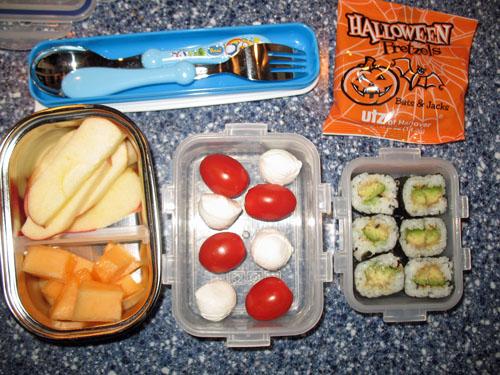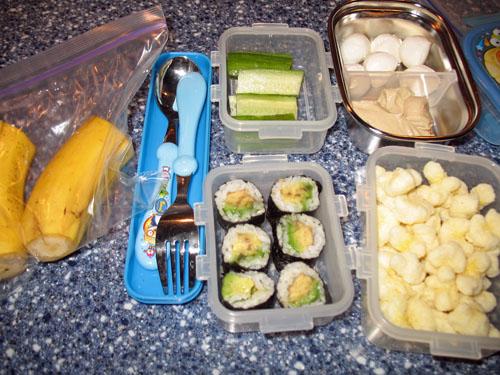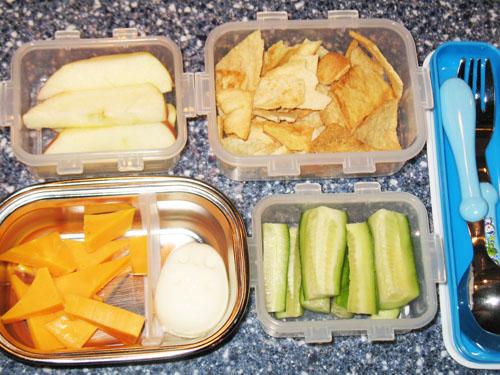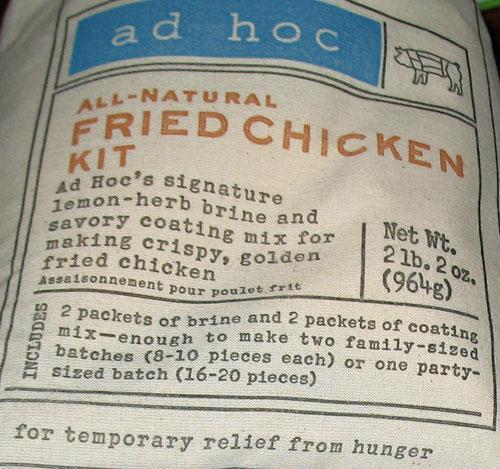-
Posts
28,458 -
Joined
-
Last visited
Content Type
Profiles
Forums
Store
Help Articles
Everything posted by Fat Guy
-
Frozen strawberries don't seem to be too much of a challenge for my normal Waring blender. Frozen fruit of any kind tends to puree up pretty easily, assuming you get a sufficient liquid (water, juice, milk, whatever) in there with it. The big challenges for my blender seem to be 1- some fruits, such as blackberries with their little seeds, don't puree to complete smoothness in the regular blender; 2- the regular blender is not great at breaking down ice to a smooth texture; and (therefore) 3- the regular blender requires more liquid than high-power blenders. Bananas, for me, aren't really a tool to provide sweetness. They're a textural element. They provide creaminess. For pure sweetness, apples seem to work pretty well.
-
Part of PJ's haul from Halloween consists of several (maybe 8) small bags of Utz Halloween pretzels. So this week the plan is that he'll be getting such a bag with each lunch. I still haven't been through the debriefing process with him, though, so I don't actually know if he was able to open the bag himself yesterday (one of the lunch rules is that the kids are supposed to be able to open everything without help from the teachers). Anyway ... aside from the "Bats & Jacks" Halloween pretzels, yesterday's lunch was all stuff we've seen before: avocado maki, mozzarella-and-tomato, apple, cantaloupe, fork, spoon.
-
As I get a little closer to thinking a high-power blender purchase is justified, my mental picture of the relevant criteria comes into focus. There seem to be a few factors that influence blender performance. Horsepower is one of them. In terms of raw horsepower, the Vita products are actually not at the top of the hierarchy. The Waring Xtreme is 3.5. The Blendtec models tend to be 3. Almost every Vita unit is in the 2s, except for one that's 3. But raw horsepower is only one consideration. There's the way speed is controlled, there's blade design, pitcher design and various other things. These seem to be the areas in which the Vita products really excel.
-
When I saw several nominations for Heath, I realized how much I like Heath bars. So this afternoon I decided to buy one and eat it. If there are a few places on Earth that could be said to be the center of everything, one of them is surely Grand Central Station. That's where I was, heading to an appointment on 41st and Madison. I visited a number of newsstands and shops in Grand Central, and several others on 42nd Street and along Madison Avenue, where I walked 4 blocks past my destination in search of a Heath bar. I couldn't find a Heath bar anywhere in or around Grand Central Station. I'm sure there was one somewhere, but I checked a lot of places and they had none. They all, however, had Snickers, M&Ms, Hershey bars, Twix and several others. So I have to conclude that Heath is a specialty product rather than a true mass-market product. The genesis of this topic, for me, was in a class I'm taking. To be licensed as a teacher in a New York career school, I need 90 hours of certification classes. These classes last 7.5 hours each on a Sunday down in the vicinity of Macy's, which is a real no-man's land on Sundays. The school where the classes are held is, I think, a school where people go to train to be things like EMTs. The days are long and so the vending machines become a focal point. In the class with me are several people who teach at area culinary schools (in addition to people who teach everything from nursing to music production to welding) like FCI, ICE and CIA, and one guy who teaches cooking in a place that seems to be one step removed from a prison. Anyway, I was standing around the vending machine with a few chef-instructors, including one who is the former pastry chef at two of the city's best restaurants, and the subject turned to "Which of these vending-machine offerings pass muster as actual delicious treats?" I thought about starting a topic devoted to vending-machine items, but I realized that would be too narrow. So I framed it in terms of mass-market treats. I can't really anticipate the twists and turns the discussion will take, and it's hard to rule on, for example, whether ice cream counts. But I'm enjoying everybody's posts.
-
Yes, I'm pretty sure it was Keller who, when asked "Who cooks the food at your restaurants when you're not there?" answered "The same people who cook the food at my restaurants when I am there."
-
I'm taking a class on Sundays -- a long, long class -- and there are several chefs in it, including pastry. One of the things we've been talking about, standing around the vending machine during breaks, is which mass-produced sweets are the best. Most are barely edible if you're accustomed to good sweets. But the following three widely available sweets are, I think, tasty: 1. Snickers. Most candy bars are just bad: low-quality chocolate, artificial-tasting fillings, too sweet, poorly conceived ratios. But Snickers works for me. There's so little chocolate that its quality isn't paramount. The caramel/peanut/nougat filling is tasty. And the bars are remarkably balanced and consistent over time. 2. Oreos. I really enjoy Oreos. I think they used to be a little better -- maybe they used to have animal fat? -- but they're still good. 3. Famous Amos chocolate-chip cookies. While I don't necessarily favor cookies at the dry-crunchy end of the spectrum, these are pretty good examples of the style. They do in a pinch. What's your list of three? We're talking about the major, nationally available (in your country -- I'm referring to the US but of course you may live elsewhere), mass-produced snacks. Not great regional stuff but the stuff you can find pretty much anywhere.
-
Well, another week went past without much growth in my bento making. And over the weekend I never managed to acquire new containers, new products, etc., so this week's lunches will be remarkably similar to what has come before. But for the record here are the last two lunches from last week. Wednesday: avocado maki, cucumber, mozzarella balls and hummus, "Pirate's Booty" crunchy cheese puffs, a banana halved with notches made to facilitate peeling Thursday: hard-cooked egg in bunny mold, cheddar cheese, apple slices, cucumbers, pita chips
-
If the texture of the chicken is the primary concern, one strategy is to take a cue from the Chinese and try velveting. Another thing I was thinking is that the trimmings from 5 lbs. of chicken breasts may not have enough firepower to make a very good stock.
-
That means the co-author did a good job! I'm not actually aware of any restaurant chef who has written a cookbook, as opposed to having it written by a co-author. Maybe there's an exception out there somewhere, but in this case the Momofuku book was written by Peter Meehan, former $25-and-under critic for the New York Times. Meehan even gets cover credit. There's a chat with Meehan and Chang on Amazon.com for anyone who would like to listen. I haven't done so yet but plan to eventually.
-
As far as I know he spends time in all his kitchens (FL, Per Se, the Bouchones, Ad Hoc) as well as on other projects, but his base of operations is Yountville CA and he spends more time at FL than at the others.
-
I believe Gourmet, over the course of many years of reviewing restaurants, never awarded stars or ranked numerically. I think that, all other things being equal -- awareness of the issues, ability to separate personal short-term business gain from long-term issues of theory, etc. -- a practitioner's opinion about any given creative endeavor carries more weight than the opinion of a non-practitioner. But those things tend not to be equal. There's no need to insult chefs, musicians or any other group of creative artists to say that. Practitioners tend to be hard-working people concerned about the next paycheck. They create the art but at the same time tend to focus on the practical and short-term. And we already know that, practically and in the short-term, stars are good for business. That's what even the most academic of chefs and restaurateurs will tell you off record: they think the stars are silly and reductive, but they're good for business. On record you'll not likely get anything out of people in the industry, because they're not about to try to fight city hall. Nor should they be expected to. Chefs and restaurateurs are practitioners of gastronomy, but gastronomy as an art exists separate from them and separate from any other group of people such as consumers or critics. Judgments about gastronomy, what's good for it, bad for it, supportive of it, insulting to it, need to be made on the merits of the arguments, not based on opinion polls of any given group.
-
Whether or not chefs are for or against star ratings is irrelevant. They don't get to decide what's an insult to gastronomy. Most of them aren't even well-suited to making determinations like that. Quantitative ratings for art are insulting to art. Whether or not the artists agree, or know enough to agree or disagree, doesn't affect that determination.
-
Probably the best piece ever written on this subject was James Poniewozik's "Media Circus" column in Salon more than a decade ago. He makes a number of arguments against star and numeric ratings (which are the same thing), most importantly that they are self-defeating for critics: that once you reduce real criticism to numbers you create the conditions for not needing real criticism. While the New York Times and other publications surely believe that giving up star ratings would be a commercial blunder, the reality may be that the star ratings are exactly what is allowing mainstream restaurant reviews to become irrelevant. But no matter, stars are here to stay. We can safely say "they're a bad idea, but we're stuck with them" and move on to the question of how to have them be as useful as possible. This is where those who award stars have traditionally fallen down on the job. The New York Times and others should at least try to explain their star systems better, rather than simply issue smug and murky verdicts that are less useful than they can be.
-
It's probably a good business decision. I know with respect to my own dining-out habits, in the past several years I have happily paid to dine at Bread Bar on many, many occasions but haven't done Tabla upstairs except for by-invitation events. And I'm someone who thinks Floyd Cardoz's food is great. It's just that Tabla upstairs wasn't a place I chose, given all the competing choices, for a fine-dining meal. Now, with the spaces integrated, I'll have more interest in the whole restaurant. At the same time, I have two regrets: 1- The new menu lacks the best dish in the history of Bread Bar, the pulled-lamb naanini; and 2- I worry that the restaurant won't be able to hold on to a New York Times three-star ranking upon re-review with this new menu.
-
This week's review is more than solid, and a huge improvement over the first two lackluster reviews. I just hope it's not a pattern that he does a great job only with the $25-and-Under places.
-
Due mostly to the allergy culture, sharing is strictly forbidden at our son's school as well as at the schools of many other families I know here in the US.
-
The thing is, that already happens. Even though by real Bento standards the lunches I make are unremarkable, they are 99.9th percentile by American school-lunch standards. The teachers, the other parents and the other kids all think PJ's lunches are so fantastically creative because he gets exotic things like avocado maki. I need you people to push me and remind me that I'm actually a slacker and not a superstar.
-
I'm so disappointed with myself for not using cookie cutters, not using my rice molds, only ever using the egg molds once, never making checkerboard sandwiches, never rolling my own maki, etc. I had grand plans to become the Greatest American Bento Maker but have settled for much less. The good thing about forcing myself to post a photo of every lunch here is that I can get some peer pressure. Because you can be sure there's no peer pressure from the other parents at my son's school. You should see what their kids get for lunch.
-
Those seem to be the primary available paths. I'm sure there are others but it tends to be either 1- you get an entry-level position at a periodical or in publishing, 2- you're already in the field and you transition to food, or 3- you start out independently online or through self publishing.
-
The green grapes this year have been amazingly large. Each one is like a whole piece of fruit. That's why I always cut them in half for PJ. They're also quite good.
-
-
What it says on the bag is "All-Natural FRIED CHICKEN KIT Ad Hoc's signature lemon-herb brine and savory coating mix for making crispy, golden fried chicken" and "INCLUDES 2 packets of brine and 2 packets of coating mix -- enough to make two family-sized batches (8-10 pieces each) or one party-sized batch (16-20 pieces)"
-

Cleaning & De-Waxing Citrus for Garnishes, Punch, etc.
Fat Guy replied to a topic in Kitchen Consumer
The answer is: surfactant. There are surfactants sold specifically as produce-wash solutions, some organic, and there are home-concocted surfactants ranging from diluted dishsoap to vinegar. We had a discussion about produce wash in '07 and I think those who got involved had good results with both produce-wash products and diluted dishsoap (the dishsoap being a lot cheaper). What I learned then, and what I've learned many times since, is that washing fruits and vegetables -- especially those coated with wax like apples, cucumbers and citrus fruits -- is a lot like washing anything else. If you do it with just water, or just water and scrubbing, you don't necessarily do as well as when you give yourself a chemical boost with a surfactant that breaks up wax and oil (actually it's about surface tension, but the result is that it breaks up wax and oil). Also in the category of a chemical boost: warm water is better than cold. Physical scrubbing has its place too, though with the help of a surfactant you don't need to work nearly as hard. If I fill a bowl with warm water and produce wash, and soak a few lemons for a few minutes, then just sort of scrub with my bare hands, they come out really nice and clean. -
As the last couple of posts imply, it's not necessarily a correct assumption that getting all the gunk off the seeds is a desirable outcome. A little pumpkin goo actually helps the flavor of roasted pumpkin seeds, which sort of need all the help they can get. We roasted the seeds of two pumpkins this weekend and just used fingers to get the worst of the goo and fiber off then salted and roasted them. In my experience -- which admittedly is not vast -- if you wash them off you wash off a lot of flavor.
-
A VitaMix/Prep or other high-power blender may be difficult to pass off as the old blender. The high-power models are massive. I couldn't believe how puny my regular Waring looked next to the Xtreme. When you see something in Costco (or most any store for that matter) it's hard to get an idea of scale. But a high-power blender can really dominate a kitchen when it's in use. There's a whole literature of savory smoothies out there, focusing in particular on "blended salads." What I've read is that, when you chew a salad, you fail to break down a very high percentage of the cellulose in the lettuce and other vegetables. Whereas, when you blend it (especially in a high-power blender), you break down the cells and can therefore utilize more of the nutrients.





